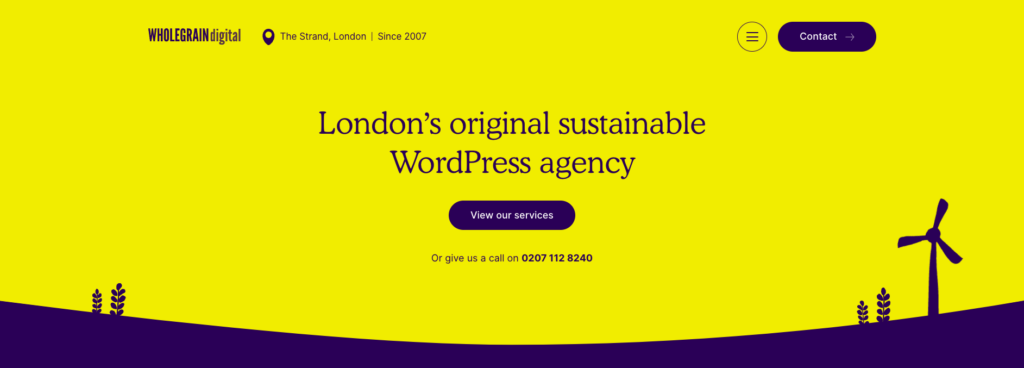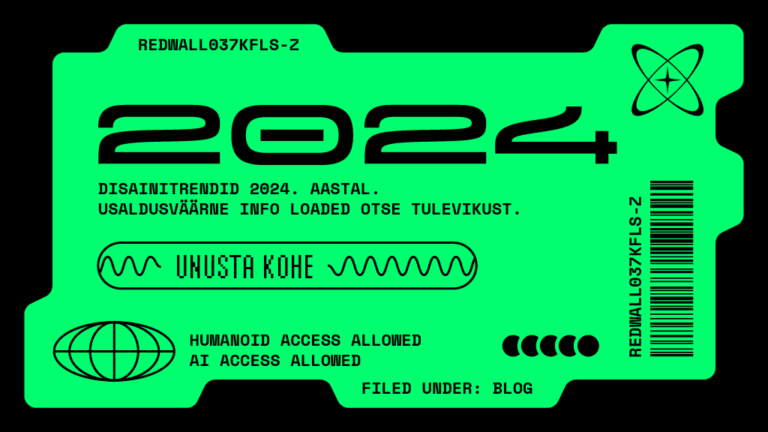15 min
Life has become faster, and information and services need to be accessible instantly. Page loading speed has become extremely important, which means comprehensive optimization (images, code, caching, etc.) is crucial in development.
People are also spending more time online, even just for entertainment. The use of mobile devices to access websites has skyrocketed. After all, the whole world is in our pocket. Screens with non-standard dimensions are becoming increasingly common, and traditional responsive layouts in development may no longer cover the latest screen widths. Instead of the usual practice, page layout compatibility should now start from as little as 280 pixels wide, if not even less.
More and more attention is being given to the concept of Multi Experience. Any process that can be done more conveniently and quickly is welcomed with open arms. The simplest example is paying with a phone or smartwatch, but there are an increasing number of services that can be used in alternative ways—ordering food from a gas station without waiting in line, booking an Airbnb through voice commands, and so on. An app or website must be built efficiently, saving time and providing maximum convenience for the user.
To feel confident as an everyday user, to understand changes as an enthusiast, or to stay on track as an IT specialist, it’s important to stay up to date with the development of new technologies. In web development, one must adapt to a changing world and pay attention to current needs. In addition to the general principles (fast, optimized, multifunctional, and user-friendly), here are some key points to keep an eye on in the coming years.
9 keywords for the new year
1. Web 3.0
In Web 1.0, websites were static—a so-called readable internet. Web 2.0 became significantly more dynamic, allowing users to create and contribute content themselves. Social media is considered a key factor in this evolution. Now, however, we are heading toward Web 3.0, which could fulfill the original dream of World Wide Web creator Tim Berners-Lee: a semantic web.
Web 3.0 has not yet been clearly defined, and it’s believed to still be far from widespread adoption. Just as it took around 20 years for Web 1.0 to evolve, the same might apply to Web 3.0. However, I believe that modern technological development is significantly faster. Web 3.0 is expected to represent a decentralized, democratic internet with much broader possibilities for everyday users and content creators.
Sounds familiar, yet somehow a bit distant? In reality, many of the foundational pillars are already in place or evolving rapidly—such as blockchain, voice commands, augmented reality, machine learning, artificial intelligence, and more. Therefore, one could assume that we might reach the “smart” internet—Web 3.0—much sooner than expected. By applying these various technologies in our work, we are contributing to the exponential advancement of the entire Internet.
2. Artificial Intelligence (AI) and Blockchain
There is a strong and convincing view that artificial intelligence is not trying to replace humans—nor can it. According to many trend blogs, the year 2024 marks the beginning of an era where AI becomes intertwined with our daily lives. There’s probably no point in fighting against AI; instead, it’s worth asking how to put it to work for your own benefit.
In web development, chatbots and virtual assistants are already in use. In the medical field, AI is applied in diagnostics and can be helpful in addressing various mental health issues. In the financial sector, AI assists in making more accurate calculations, generating analyses, or trading on stock markets. In business, AI is used for brainstorming—saving time and expanding perspectives. In industrial companies, AI is valuable for quality control in production, automation (including testing in web development), and planning logistical routes. In some areas, experiments are already being conducted to predict human emotions in specific contexts, which may play an important role in shaping project briefs, strategies, and web design in the future.

The MDR system—originally known as Medical Device Reporting but now evolving into Managed Detection and Response—is becoming increasingly important in web development as well. This system has become a core part of cybersecurity, continuously monitoring websites, applications, or devices for risks and helping to identify vulnerabilities. Cloud-based threat detection can also be used, which is ideal when the goal is to leave the software untouched while maintaining optimal performance. Increasingly, cybersecurity is likely to rely on the collaboration between AI and blockchain—AI detects threats, while blockchain ensures secure data storage and decentralized “transactions.”
AI is increasingly permeating highly sensitive and data-critical sectors, making robust cybersecurity systems especially vital in fields like healthcare, finance, and the military. National election systems are also gradually moving toward blockchain-based solutions, aiming to ensure transparency, security, and trust in the democratic process.
Wherever AI is used, it reduces the likelihood of human error, increases the accessibility of services, helps to think outside the box, and saves working hours — which in turn saves money.
With the widespread use of AI, the issue of ethical AI “consumption” is becoming increasingly important in order to build trust in AI-powered tools and applications. The rule of thumb with AI is: garbage in, garbage out. The information fed into it must be of high quality to ensure high-quality results. Universities are already offering courses that teach how to use ChatGPT responsibly and how to decide when it makes sense to rely on AI — and when it’s better to preserve human authenticity and logical thinking.
For the Enthusiast
- If you’re especially interested in AI, some of the key skills to focus on are machine learning and data analysis.
- On the large data science platform Kaggle.com, you can find a variety of competitions — including AI-focused ones — with substantial cash prizes. It’s a great place to experiment and create something yourself: for example, you could build a predictive model for a company like Enefit, or develop a fun program with friends that can detect whether a text was written by a human or AI.
3. Internet of Behaviour (IoB)
Over the years, IoT — the Internet of Things — has gained significant popularity through devices like smartwatches, intelligent thermostats, and WiFi-enabled appliances. A new keyword entering the scene is the Internet of Behaviour (IoB). This is a logical next step, as the IoT device network collects vast amounts of data about users’ interests and (consumer) behavior.
By applying data analytics and behavioral science, the information gathered can be used not just for marketing or product development, but for much more. For instance, navigation systems analyze the most commonly used routes and provide alerts if there’s a hazard ahead. When IoB is combined with AI, it’s possible to analyze consumer behavior patterns in electricity usage and make real-time adjustments in production and distribution. (The predictive model project mentioned earlier for Enefit could be a relevant example here.)
Over the next 10 years, the IoB market is predicted to grow by up to a thousandfold. However, integrating IoB into everyday life requires major advances in data protection, as breaches involving this kind of personal information have already led to massive compensation claims. This is where the data security potential of both AI and blockchain comes into play.
4. Progressive Web Apps (PWA), Low-Code Development, and Serverless Architecture
Progressive Web Apps (PWAs) are applications accessible via a regular web browser but behave like mobile apps. They’re more cost-effective to develop because only one app version is needed for all platforms (web, iOS, Android). PWAs are also more accessible, since they can be found via search engines and don’t require downloading from app stores — which also eliminates the need for frequent updates.
PWAs generally provide a better user experience for most service providers. They’re optimized and have faster load times. A major advantage is the ability to work offline — for example, users can finish reading an article or listening to a podcast even without an internet connection if the content has been downloaded. They are also more secure thanks to HTTPS connections. Some great examples of PWAs include Spotify, Tinder, YouTube PRO, and X (formerly Twitter).
Over time, many websites and applications accumulate a lot of unnecessary or “dead” code — especially when developed long ago and updated by multiple developers with different styles. This bloated code can significantly degrade performance. Applications are particularly sensitive to this, and by 2024, more than half of all apps are expected to shift toward low-code development. At Redwall, for instance, we frequently see Joomla users looking to migrate to low-code platforms like WordPress, though Joomla also offers some no-code/low-code features. In many cases, developers combine the best of both worlds by building PWA solutions using low-code or no-code methods, which improves development, management, and user experience.
Adding serverless architecture to the mix can yield impressive results. Despite the name, a server and database still exist — they’re simply hosted in the cloud. The benefit is that developers can focus solely on building the app or website, without worrying about server infrastructure. This approach is gaining momentum as it boosts loading speeds and offers flexibility: developers can work from anywhere and are no longer tied to specific hardware or physical servers. Serverless architecture also offers significant cost savings in hosting and maintenance.
5. Sustainability
When discussing the buildup of unnecessary code over time and the transition to newer solutions, it’s fitting to continue with a topic that has only recently gained attention in the context of web development and the Internet — but is becoming increasingly important: sustainability. It may sound surprising, but the carbon dioxide emissions generated by the Internet are estimated to be on par with those of the entire aviation industry or the whole continent of Africa. While avoiding air travel is often recommended to reduce one’s carbon footprint, the environmental impact of digital activity has received far less attention.
Estonia has already been a frontrunner in addressing digital waste for several years, but what can we do as everyday users or developers? Pay attention! Optimized images, clean code, data compression, and cloud/serverless architecture are all key practices here. There are even eco-friendly fonts designed to consume less energy and, when printed, save ink. A completely new branch of design is emerging — sustainable web design and development — focused on reducing the environmental impact of digital services while maintaining high usability and performance.

Optimizing software and websites is essential not only for performance but also for reducing energy consumption and carbon emissions. A significant part of this comes down to avoiding unnecessary or poorly thought-out pages and eliminating redundant code. Additionally, using cloud-based solutions helps prevent the accumulation of massive file loads on local servers.
Many applications and browsers have introduced Performance Mode — intentionally steering away from the term “Eco Mode,” which could imply a compromised user experience. In reality, Performance Mode can significantly enhance performance; for example, it allows Fortnite to run smoother or Edge to load pages faster by displaying lower-resolution versions where it doesn’t affect the core experience. This subtly conserves energy in the background without sacrificing quality. Just like we aim to preserve our natural environment, we must also ensure a sustainable digital environment. That means being mindful of digital waste, promoting clean and efficient development practices, and making use of the full life cycle of hardware — avoiding unnecessary upgrades and replacements whenever possible.
6. Extended Reality (XR) – VR, AR, MR
Most of us have heard of Virtual Reality (VR) — the ability to walk among dinosaurs or explore the long-lost Oru Palace is something that once seemed impossible. The early VR setups were expensive and not exactly user-friendly. Just like holograms — a phenomenon despite being an old technology — virtual reality is now far more powerful and accessible thanks to better equipment and innovative solutions.
Let’s rewind seven years. Park benches were empty, and groups of teens were nowhere to be seen. Instead, they wandered around, phones in hand. Some barely noticed approaching cars, stopping just in time. Everyone remembers Pokémon Go, the wildly popular 2016 game. Others who didn’t chase Pikachu were taking selfies with cat whiskers in Snapchat. Some watched it all with disapproval, filing it under “kids these days.” These were arguably the first and most well-known Augmented Reality (AR) experiences introduced to the mainstream, spreading like wildfire. The line between the virtual and real world suddenly became very, very thin. To some, this was actually Mixed Reality (MR) — a term covering everything in between VR and AR — but we’ll leave that debate to the tech purists.

Nowadays, we’re already talking about Extended Reality (XR) — an umbrella term that includes VR, AR, and MR — but in a completely new context. The coming years will bring XR experiences even closer to everyday life. Extended reality is being used for military simulations, medical and rescue training, vocational education, and more.
In web development, XR becomes particularly valuable when used to create next-level user experiences through interactive websites and engaging applications. For example, IKEA lets users see — through their phone screens — how a shelf fits on their wall or whether the measurements work. Or maybe you want to test how a Rolex watch would look on your wrist? Real estate websites offer AR-powered virtual tours that let potential buyers explore an apartment without ever meeting a realtor in person. You can even meet with a business partner “in the same room” while they’re physically relaxing in Mauritius. And car rides? They’ve been gamified with Holoride technology. In Tartu, during the Aparaaditehas cultural program, a mixed-reality art exhibition titled “Teed” recently opened in Plantarium (which, by the way, is open for visitors until February 11, 2024).
AR is right here, all around us — and more is coming. All of it with one goal: to give users something more. To provide an immersive experience that captivates them and makes them far more likely to engage with a product or service.

The digital world is increasingly integrating with the real world, and it is predicted that soon we’ll take another step forward with brain-readers, which will help people learn new skills faster. In that case, we won’t need to fear AI taking our jobs — but rather, the other person who keeps up with the innovations. Sink or swim!
7. Accessibility and voice control
One of the most important keywords in recent years in web development has definitely been accessibility, and it will remain so in the future.
Voice control is already an old concept (e.g., navigation systems, virtual assistants, smart devices), but until recently, its use in apps and websites hasn’t been very common. That’s now slowly changing. Many users prefer voice commands over typing — and not just those who have difficulty typing. It’s simply faster and more convenient.
Have you ever seen anyone enjoy typing in a YouTube search on a TV screen? Voice control is especially popular in e-commerce, for example, when searching for products. As developers, we now need to consider that clients may include such features in their requirements for a new website. That means being familiar with new standards related to voice search optimization and SEO. In the past, we didn’t need to think about voice control in such detail — but now, it’s becoming a standard part of modern development.
8. Cybersecurity
When it comes to websites, security remains one of the most crucial topics — and it continues to feature prominently on trend lists year after year. It’s particularly critical for websites related to medicine, finance, national security, or any platform that handles personal or other sensitive data. These are the types of systems with the highest potential for being targeted by cyberattacks.
As mentioned earlier, the cooperation between AI and blockchain is opening up new possibilities in the field of cybersecurity. With the increasing frequency and scale of cyberattacks, one of the most important qualities for a modern developer will be a “security-first” mindset — and this is seen as a defining trend for 2024.
Also gaining importance are privacy regulation practices that must be followed when building different types of websites and applications. And it’s not just about the initial development — security requirements are also becoming increasingly central to support and maintenance services. It’s critical to have strong knowledge of what can be done to protect and patch older websites, which might not be upgradable due to time or budget constraints but still pose significant security risks due to growing vulnerabilities.
9. CMS updates
Here we highlight the main focuses for the upcoming year of the two most popular content management systems (CMS) – Joomla! and WordPress. However, it’s always wise for companies (both developers and site managers) to keep up with the updates and trends of the CMS platforms they use the most, as these are closely related to both security and broader development possibilities.
Joomla!
Quite a few websites that use Joomla are still running on version 3, and it feels like only recently we were talking about the big migration to Joomla! 4. However, so much time has passed that version 5 has already been released. That doesn’t mean everyone should rush into updating, as many third-party plugins have yet to offer support for J!5. Still, considering that a large number of sites are still on J!3, the migration to J!4 is somewhat complex and a bigger undertaking, and support for J!4 will only last two more years, it’s pushing many to already start thinking about the J!5 update. So, 2024 and the years following are shaping up to be significant years for website maintenance specialists focused on updates. For a more in-depth look at the transition, you can read our blog post about the internal insights into the new version.

What exciting things can be expected from the Joomla! 5 update?
Read moreWordPress
WordPress is constantly rolling out updates, so we won’t highlight anything specific here — but the WP development team has outlined their goals for the coming year.
- In 2024, we can expect an even larger selection of plugins and themes supporting headless WordPress websites. This means that WordPress is used only for content management, while the front end is built using frameworks like Vue.js or React.
- Over the next few years, there will be a noticeable rise in plugins and themes integrated with AI, aimed at enhancing user engagement, experience, and efficiency.
- One notable output will be the creation of PWA (Progressive Web App) applications using WordPress.
- Given that accessibility has been a major focus in recent years, this trend will continue into 2024, with even more tools and add-ons developed for this area.
- We’ll also see more block-based themes, reducing the need for extensive custom development. Creating complex designs will become easier, requiring only minor code customizations.
- There will be an increased focus on security, along with monitoring tools and new authentication methods.
- Speed and source code optimization will remain a top priority.
- Finally, one of WordPress’s core goals for the coming years is sustainability, promoting a greener mindset in development practices, hosting solutions, and minimizing site bloat.
In conclusion
Each of us can decide for ourselves whether the changing world and digital space is something to look forward to with excitement — or something that causes anxiety. High-quality technology and infrastructure make it possible to deliver greater value to clients with smaller budgets, and those who are adaptable to change will find it easier to offer that value. From this list, it’s definitely worth learning at least one new skill or adjusting some of your current practices to better fit into your daily work.
And finally, a touch of witty humor to wrap things up:



